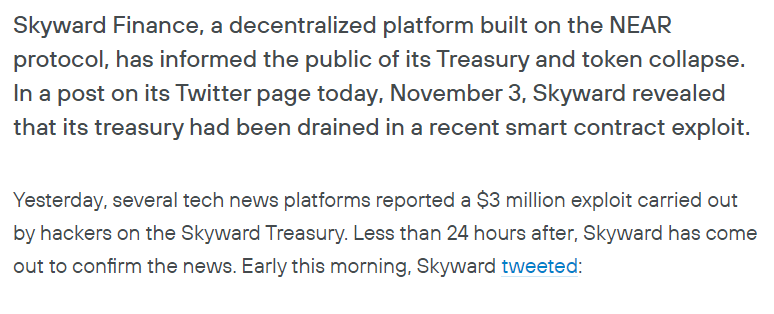How has the hack impacted Skyward?
The intention of this dashboard is to track the activity of Skyward Finance platform before and after the entity was hacked on November 22.
The NEAR ecosystem is rapidly expanding; each project on the platform attracts additional users and developers who can benefit from the ecosystem’s technologies. With a transaction cost of $0.1 and a transaction processing speed of 100,000 transactions per second. NEAR is a great place to start deploying decentralized exchanges.
One of the most interesting platforms that created hype and was of an interest of a huge part of Near wallets was Skyward. Skyward Finance is a rapidly growing decentralized finance (DeFi) platform built on the NEAR Protocol. It offers users a range of financial products and services, including liquidity pools, yield farming, and cross-chain trading. By leveraging the power of blockchain technology, Skyward Finance aims to create a more open, transparent, and secure financial system that is accessible to anyone, anywhere in the world. With its user-friendly interface, innovative features, and strong community support, Skyward Finance has quickly become one of the most promising DeFi platforms on the NEAR ecosystem.

However, in November 3rd 2022, has informed the public of its Treasury and token collapse. In a post on its Twitter page today, November 3, Skyward revealed that its treasury had been drained in a recent smart contract exploit.
Thus, the platform's activity on NEAR has been impacted by a recent hack, which has led to a decrease in transaction volume, active wallets, and NEAR transferred out. This report aims to provide a deeper analysis of the impact of the hack on Skyward Finance's activity on NEAR Protocol.
The methodology for the analysis of Skyward Finance's activity before and after the hack on NEAR Protocol can be outlined as follows:
Data Collection: Collect relevant data points for the selected time range from before and after the hack. This includes transaction data, user activity, fees, token usage, and swaps. The data should be collected for Skyward Finance as well as the entire NEAR ecosystem for comparison.
Data Cleaning and Preparation: Clean and prepare the collected data for analysis. This includes removing duplicates, formatting data types, and addressing any outliers or missing values.
Data Analysis: Use appropriate statistical and data visualization techniques to analyze the data and identify any patterns or trends. Calculate relevant metrics such as transaction volume, number of users, fees, and user activity, and compare them before and after the hack.
Dashboard Creation: Develop a user-friendly dashboard that allows the user to select the time range and view relevant metrics for Skyward Finance and the NEAR ecosystem. The dashboard should provide visualizations and allow the user to explore the data further.
Results and Conclusions: Share the results of the analysis and provide conclusions based on the findings. Discuss any notable changes in activity before and after the hack and compare Skyward Finance's activity to the rest of the NEAR ecosystem. Provide recommendations for further analysis and potential improvements to the dashboard.